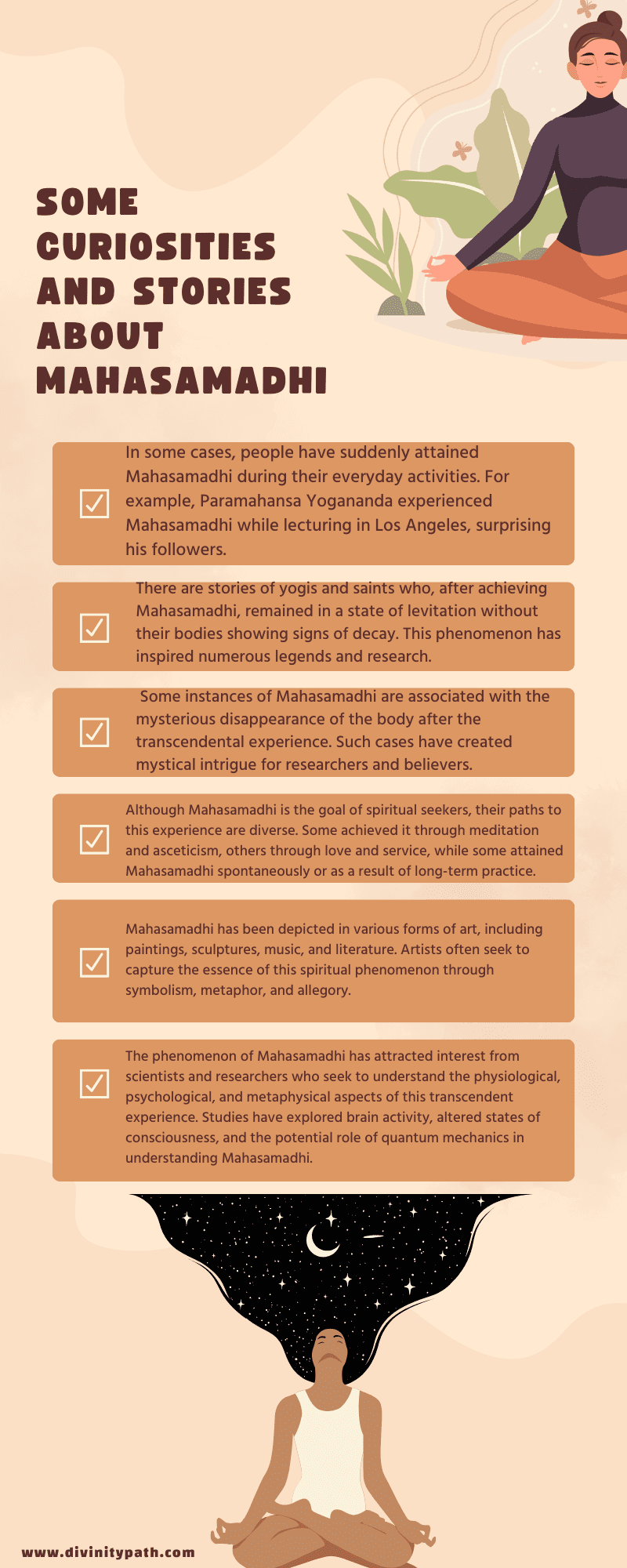Everything You Need To Know About Mahasamadhi And How To Achieve It
Have you ever thought about a concept that transcends the boundaries of the physical and leads us into the depths of the spiritual? Today, we will explore Mahasamadhi, an exceptional and mysterious experience described as the “great passage” or the “great cessation.” In this article, we will unveil what Mahasamadhi actually is, how it can be attained, its history, and the personalities who have experienced this transcendental state.
Do not seek Mahasamadhi as an end to your suffering. To seek Mahasamadhi means to see how to evolve life to another dimension
-Sadhguru
What is Mahasamadhi?
Mahasamadhi is an ancient concept from Hinduism and yoga, signifying complete and permanent union with the divine or universal. This state is achieved at the end of physical life and is often associated with extraordinarily spiritually developed individuals who consciously leave their physical bodies to merge completely with the absolute. However, it is not the same as natural physical death experienced by all.
This goal (Mahasamadhi) is set by spiritual seekers, thus disciplining their spiritual endeavors until they reach Nirvikalpa Samadhi, which is a higher level where the ego dissolves, and only pure consciousness operates. In Nirvikalpa Samadhi, there is no mind as you know it, but only divine peace, infinite bliss. Direct translations vary greatly from BLESSING or ENLIGHTENMENT as well as from LIBERATION.

You have probably heard of the spiritual teacher Sadhguru, who says, “Everyone says they are seeking freedom, but they are actually working for slavery. Everyone is trying to attach themselves to something or someone. Whether a man tries to attach himself to a woman, a woman to a man, or to God, a party, an ideology, a philosophy, a belief system, or now Isha. No matter what you attach yourself to, you are trying to find some meaning.”
Achieving Mahasamadhi is a process
Achieving Mahasamadhi is a process that requires dedication, patience, and deep spiritual understanding. Although there is no uniform recipe for achieving Mahasamadhi, you can follow some general principles and practices traditionally associated with this experience. Here are some key steps and principles:
Practice of yoga and meditation
Yoga and meditation are fundamental practices that lead to inner development and spiritual growth. Regular practice of asanas, pranayama (breathing techniques), and dhyana (meditation) can help balance the mind, body, and spirit and create conditions for deeper spiritual experiences.
Self-awareness and understanding of truth
An important step toward Mahasamadhi is understanding the truth about oneself and the world around oneself. This involves recognizing the illusion of the ego, which separates us from the universal, and understanding the truth about the nature of existence and the unity of all.
Dedication to spiritual development
Dedication to spiritual development is crucial. This means allegiance to a higher truth or the divine and a commitment to work on one’s own spiritual progress. This may include serving others, praying, meditation, reading sacred texts, and listening to spiritual teachers.
Clearing karmic bonds
Clearing karmic bonds and burdens is crucial for the liberation of the soul and achieving higher states of consciousness. This may involve performing actions without attachment to the fruits, forgiving others, and accepting karma as a means of spiritual growth.
Deepening spiritual practices
Deepening spiritual practices, such as japa (repeating sacred words or mantras), devotion, and performing spiritual exercises, can help strengthen your connection to the divine and create conditions for Mahasamadhi.
Dedication to seeking truth
Mahasamadhi is an expression of dedication to seeking truth and completely merging with the universal. This dedication must be complete and unconditional, meaning you must be willing to renounce everything that separates you from the ultimate truth and unity.
Spiritual teaching and mentoring
Having a spiritual teacher or guide can greatly facilitate the path to Mahasamadhi. A spiritual teacher can offer guidance, wisdom, and support in your spiritual development and help you understand and overcome obstacles on the path.
The origin of Mahasamadhi dates back thousands of years
The first records of Mahasamadhi date back to ancient Hindu textual traditions, such as the Vedas and Upanishads, which describe concepts of transcendent states of consciousness and spiritual liberation. Mahasamadhi is often associated with yogic practices, such as asanas (physical exercises), pranayama (breathing techniques), and meditation, which were developed to achieve unity with the divine.
In the yogic tradition, Mahasamadhi, as a transcendental state achieved at the end of physical life, has been studied and practiced by numerous saints, yogis, and spiritual teachers over millennia. These spiritual giants, with their experiences and teachings, have contributed to the consolidation and dissemination of understanding Mahasamadhi in the Hindu and broader spiritual community.
The popularization of Mahasamadhi also played a significant role in the influence of yogic texts, such as the Yoga Sutras of Patanjali, Hatha Yoga Pradipika, and Bhagavad Gita, which described various aspects of yogic practice, including spiritual achievements such as Mahasamadhi.
In modern times, Mahasamadhi has become part of the global spiritual culture, attracting many seekers of truth and spirituality. Influential spiritual teachers such as Paramahansa Yogananda, Ramana Maharshi, and Sri Aurobindo have contributed to the spread of interest in Mahasamadhi and its understanding through their works and experiences.
Personalities associated with Mahasamadhi
Let’s look at some personalities who, with their lives, teachings, and spiritual achievements, have left a profound mark on the history of spirituality and continue to serve as a source of inspiration and wisdom for many seekers of truth.
Sri Ramakrishna Paramahansa
Sri Ramakrishna Paramahansa was a Hindu saint and mystic who lived in the 19th century in India. He was a teacher and spiritual leader known for his exceptional devotion and love for God. After Sri Ramakrishna’s death, his followers witnessed his attainment of Mahasamadhi, marked by a profound spiritual experience.
Paramahansa Yogananda
Paramahansa Yogananda was an Indian yogi and spiritual teacher who brought the teachings of Kriya Yoga to the West. He was the author of the popular book “Autobiography of a Yogi,” which inspired millions of people worldwide. In 1952, Paramahansa Yogananda attained Mahasamadhi while lecturing in Los Angeles.
Ramana Maharshi
Ramana Maharshi was an Indian saint and teacher of self-realization, known for his teachings of Advaita Vedanta. He spent most of his life in an ashram in Tiruvannamalai in southern India, where he guided numerous seekers of truth. Ramana Maharshi attained Mahasamadhi in 1950.
Sri Aurobindo
Sri Aurobindo was an Indian philosopher, poet, yogi, and spiritual leader who introduced the concept of integral yoga. He founded an ashram in Puducherry, where he led numerous followers in their spiritual practice. Sri Aurobindo attained Mahasamadhi in 1950.
Anandamayi Ma
Anandamayi Ma was a renowned Hindu saint who lived in the 20th century in India. She was known for her exceptional devotion and love for God and had a wide base of followers worldwide. Anandamayi Ma attained Mahasamadhi in 1982.
How is ego connected to Mahasamadhi?
The ego is closely linked to experiencing Mahasamadhi and the spiritual journey in general. As we know, the ego represents identification with our physical body, mind, desires, and beliefs, which separates us from our true spiritual nature. To achieve Mahasamadhi, it is often necessary to overcome the illusion of the ego and free ourselves from attachment to material things and identifications with the self, “I”.
Jalal al-Din Rumi (Maulana) (1207), the famous poet and Sufi mystic, speaks extensively about the death of the ego in his poems, as only through this can we awaken universal consciousness. We usually cannot completely rid ourselves of our ego, but we can soften it.
On the spiritual journey, we must turn to truth and grow with love and simply let go of the ego; only then can we achieve the “complete.” Through his poems, he speaks of his knowledge of spiritual states and progresses in initiatory ascension. This excerpt is from his book Masnavi:
I died in a mineral state and became a plant, I died in a plant and reached an animal, died in the animal and became human. What should I be afraid of then? I never died a death. At the next charge (forward) I will die for human nature, that I may raise (my) head and wings (and rise) among the angels, and I have to (also) jump out of the river (state) Angel, Everything dies except His face, I will be sacrificed again from the (state) of an angel, I will become what cannot be imagined, Then I will become non-existent; non-existence tells me (in tones) as an organ: Really, let's get back to him.
Who would actually desire conscious death?
The desire for conscious dying arises from longing for something greater than mere physical life. Imagine being on a journey where you want to achieve something perfect, something greater than what you usually experience. It’s similar to seeking a treasure – but this treasure is not material, it’s spiritual.
For some people, this treasure is complete unity with the universe or the Divine. They want to achieve perfect connection with this Divine, which in their eyes is the source of all love, wisdom, and harmony. And although death may seem like the ultimate end, for them, it’s not the end but a transition to a higher level of consciousness, where they merge completely with the Divine.
For these people, death is just a gateway leading to eternal peace, love, and happiness. And so, if they reach a point where they are ready, they can choose to embrace this journey with open arms, knowing that they will attain the treasure they seek so fervently. It’s like achieving the goal of one’s life, only this goal includes something beyond this world, which deeply moves and inspires some people.









